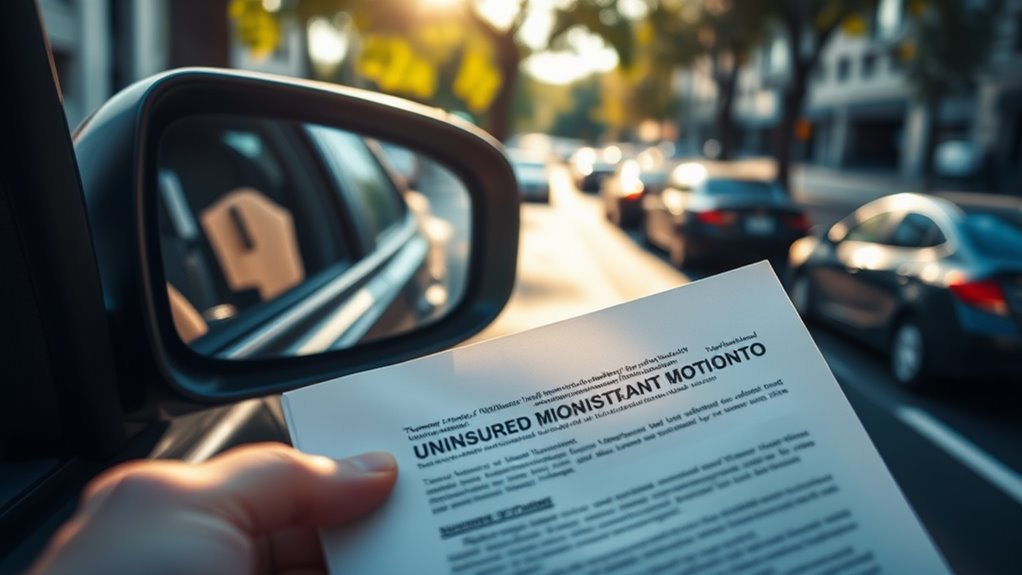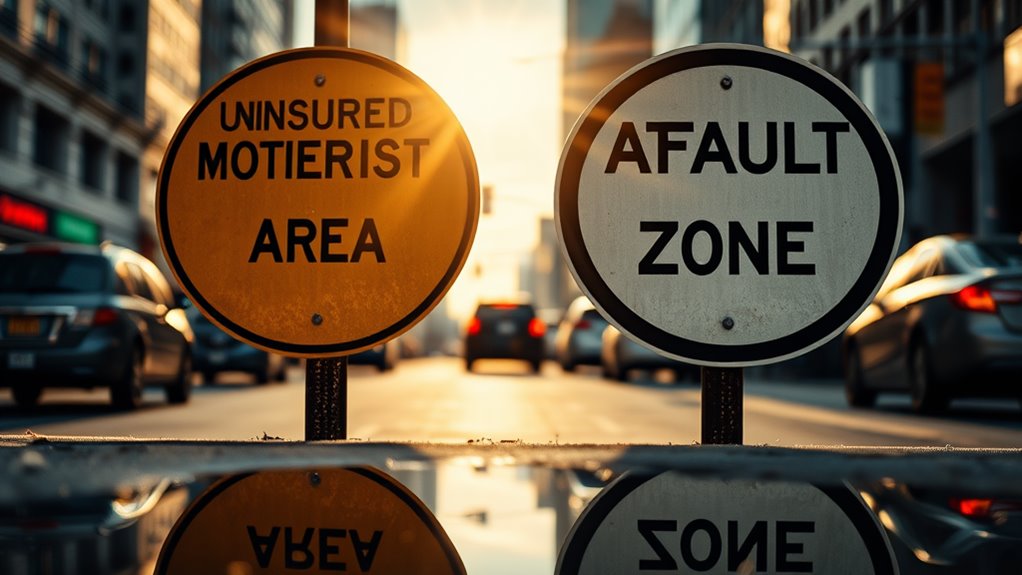Understanding how uninsured motorist (UM) coverage impacts your premiums is essential for making informed insurance decisions. Various factors, such as state laws and claim history, play a significant role in determining your rates. When you file a UM claim, you might notice an average increase in your premiums, but the specifics can vary widely. It's vital to explore how these elements interact and what strategies you can employ to manage your costs effectively.
Key Takeaways
- Uninsured motorist claims can lead to average annual premium increases, typically around $98, impacting overall insurance costs.
- States vary in protections against premium increases; some prohibit hikes after UM claims, while others allow insurers to raise rates.
- The severity of damages and involvement in hit-and-run incidents can influence the extent of premium increases following UM claims.
- Insurers treat uninsured motorist claims as first-party claims, typically resulting in lower premium increases compared to at-fault liability claims.
- Shopping around for insurance can help identify competitive premiums and coverage options, potentially mitigating the impact of UM claims on rates.
Understanding Uninsured Motorist Coverage and Its Importance

While you mightn't often think about the risks of encountering an uninsured driver, understanding uninsured motorist (UM) coverage is crucial for safeguarding your financial well-being.
UM coverage protects you if you're involved in an accident with a driver who lacks insurance or has insufficient coverage. This type of policy covers medical expenses, lost wages, and vehicle repairs, providing essential financial support amid an unexpected incident. Approximately 13% of drivers are uninsured, emphasizing the importance of having this coverage in place. Additionally, affordable auto insurance options can help ensure you can get this important protection without breaking the bank.
Many states require UM coverage, though specifics can vary, and about 13% to 14% of drivers are uninsured, highlighting the risk. Additionally, it offers peace of mind and asset protection, ensuring your personal finances aren't depleted in a liability dispute. Knowing these factors can help you make informed insurance decisions.
Legal Protections Against Premium Increases
Understanding the legal protections against premium increases is essential for consumers maneuvering the complexities of auto insurance. In states like California, laws such as Prop 103 prevent insurers from raising premiums after an uninsured motorist claim unless specific exceptions apply, such as multiple claims in a short timeframe.
However, most states lack similar protections, allowing insurers to adjust rates after claims. Additionally, regulations in states like New York require insurers to notify consumers about policy changes well in advance, promoting transparency.
Despite these efforts, many consumers still face rate increases even if they weren't at fault in accidents. Consequently, understanding your state's regulations is vital for safeguarding against unjust premium hikes.
Average Premium Increases From Uninsured Motorist Claims
Filing an uninsured motorist claim often leads to increased insurance premiums, a reality that varies considerably among different insurers.
On average, you might see your rates rise by about $98 annually after such a claim. However, specific regions, like Maryland, report smaller increases of around $43 per year.
Factors influencing these changes include the extent of damages and whether the accident was a hit-and-run.
Insurers like Progressive and GEICO tend to impose larger rate hikes, while State Farm typically refrains from increasing rates following these claims.
Ultimately, the severity of the incident and your claims history play significant roles in determining how much your premiums will increase after filing an uninsured motorist claim.
Comparison of Uninsured vs. At-Fault Claims on Premiums

When comparing the effects of uninsured motorist claims to at-fault claims on insurance premiums, it's essential to recognize their distinct categorizations and implications.
Here are three key differences:
- Claim Type: Uninsured motorist claims are first-party claims, while at-fault claims involve liability, impacting premiums differently.
- Risk Assessment: Insurers typically view at-fault claims as strong risk indicators, often resulting in higher premium increases compared to uninsured claims.
- State Protections: Some states shield consumers from rate hikes for not-at-fault claims, indirectly benefiting those filing uninsured motorist claims.
Understanding these differences helps you navigate potential premium impacts effectively and manage your coverage strategy accordingly.
Impact of State Regulations on Uninsured Motorist Coverage
While the specifics of state regulations can vary greatly, they play an essential role in shaping the landscape of uninsured motorist coverage.
Mandatory coverage in states like Illinois and New Jersey guarantees that most drivers are protected, while others, such as Massachusetts, specify bodily injury without property damage.
Differences in how states define "underinsured" affect eligibility for coverage, influencing your decisions.
States like Rhode Island only require uninsured motorist coverage if you opt for higher liability limits.
Additionally, the prevalence of uninsured drivers varies regionally, impacting your premium costs.
These regulations not only set minimum requirements but also dictate how much you'll pay based on your state's risk profile and insurance laws.
The Role of Insurance Companies in Premium Adjustments
Understanding the impact of state regulations on uninsured motorist coverage sets the stage for examining how insurance companies adjust premiums.
These adjustments hinge on several key factors:
- Risk Assessment: Insurers evaluate your driving history, geographic location, and vehicle type to determine risk levels.
- Claims Experience: The frequency and severity of your past claims notably influence future premium rates.
- Market Competition: Companies must balance profitability with competitive pricing, regularly adjusting premiums to attract and retain policyholders.
How Multiple Claims Affect Policy Renewal

Filing multiple claims within a three-year period can greatly impact your policy renewal, as insurers view this pattern as indicative of heightened risk.
At-fault claims carry a more severe effect on premiums compared to extensive claims. If you file several extensive claims, your premiums may still rise, but typically not as drastically unless they're excessive.
This history of claims follows you, influencing rates with future insurers. The likelihood of policy non-renewal increases with multiple claims, particularly at-fault incidents, as insurers assess overall risk.
They may exercise discretion in defining "too many claims." To manage these implications, regularly review your coverage and shop around for competitive quotes to mitigate potential rate increases at renewal time.
The Financial Risks of Driving Among Uninsured Motorists
Driving among uninsured motorists poses significant financial risks that can impact your wallet and overall peace of mind.
Driving among uninsured motorists can lead to serious financial risks, affecting both your budget and peace of mind.
Here are three key financial risks to weigh:
- Increased Premiums: With approximately 13% of U.S. drivers uninsured, accidents involving these drivers can lead to higher insurance premiums for you, as insurers often pass on the costs.
- Medical Expenses: Without adequate coverage, the financial burden of medical costs from an accident can be overwhelming, potentially leading to insolvency.
- Repair Costs: If your vehicle is damaged by an uninsured driver, you may face steep out-of-pocket expenses for repairs or replacement, disrupting your daily life.
Being aware of these risks can help you make informed decisions about your insurance coverage.
The Benefits of Adding Uninsured Motorist Coverage
Accidents involving uninsured motorists can leave you vulnerable to significant financial setbacks, making it imperative to contemplate adding uninsured motorist (UM) coverage to your policy.
UM coverage not only pays for medical bills and vehicle repairs when the at-fault driver lacks insurance but also covers lost wages and pain and suffering. This protection extends to hit-and-run incidents, ensuring you're financially secure even in complex situations.
While the cost of UM coverage varies, it remains relatively affordable compared to other expenses. In high-risk areas with many uninsured drivers, having UM coverage can safeguard your financial stability.
Strategies for Shopping for Insurance With UM Coverage
When you're shopping for insurance with uninsured motorist (UM) coverage, it's important to approach the process strategically to guarantee you get the best protection at a reasonable cost.
Here are three strategies to take into account:
Consider these three strategies for securing the best uninsured motorist coverage: compare limits, bundle policies, and shop around.
- Compare Coverage Limits: Verify your UM coverage matches your potential medical expenses and property damage needs.
- Bundle Policies: Look for discounts by bundling UM with other insurance types, which can lower overall costs.
- Shop Around: Research multiple insurance providers to compare premium costs, including variations with and without UM coverage.
Conclusion
Incorporating uninsured motorist coverage into your policy is like adding a safety net beneath a tightrope; it protects you from potential financial falls. Understanding how this coverage impacts your premiums is essential, as the effects can vary widely based on state laws and personal claims history. By staying informed and strategically shopping for insurance, you can navigate the complexities of UM coverage, ensuring you're adequately protected without facing overwhelming premium increases.

